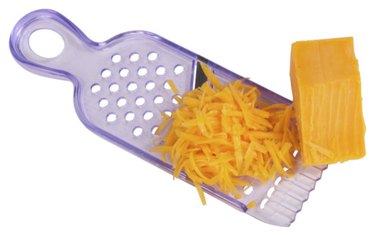
With Americans caught between a love of cheese and a need to lower their saturated fat intake, fat-free cheeses has come into the market to serve as alternatives to their saturated fat-laden counterparts. One of the issues with fat-free cheese is, however, its resistance to melting. Cheeses with normal fat contents typically melt very easily, while fat-free cheese lacks the lipid base to facilitate melting. The melting issue can be countered with the creative use of lipids or water.
Step 1
Shred the fat-free cheese. Though shredding the cheese will not make the fat-free cheese melt on its own, it does allow for the it to be mixed with other items that may facilitate the melting process.
Video of the Day
Step 2
Mix the shredded fat-free cheese with small amounts of standard cheese. The lipids from the standard cheese will combine with the fat-free cheese and promote melting. Though this does under-cut the fat-fee nature of the cheese, adding only small amounts of the regular cheese will not increase the fat content of the meal dramatically.
Step 3
Mix the shredded, fat-free cheese with small amounts of vegetable oil. Combining the fat-free cheese with the oil does have similar fat-increasing consequence as mixing it with regular cheese, but canola-based oils do not add the saturated fat that comes with regular cheese.
Step 4
Cook with moisture. Water-based moisture does not promote melting in the same way as adding lipid-heavy materials, but it does help and does not insert fat to the meal. Add small amounts of water to dishes, then cover to allow the steam to permeate the cheese. Mix the cheese with products that have some water content to create a creamier texture. These methods will not mimic the melting of standard cheese exactly, but they can bridge the gap without adding extra fat.
Video of the Day